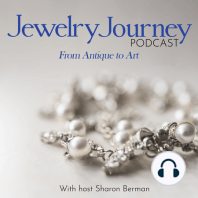23 min listen

Episode 124: Jewelry and Shoe Lovers Unite: What Our Accessories Represent with Dr. Kimberly Alexander, University of New Hampshire Faculty
Episode 124: Jewelry and Shoe Lovers Unite: What Our Accessories Represent with Dr. Kimberly Alexander, University of New Hampshire Faculty
ratings:
Length:
30 minutes
Released:
Jul 28, 2021
Format:
Podcast episode
Description
What you’ll learn in this episode: What material culture is, and how we can understand history through its lens Why people tend to save their shoes even if they don’t wear them How high heels relate to women’s sense of power—or powerlessness Why Colonial-era shoe and breeches buckles are still a popular jewelry material How the Colonial shoe industry can help us understand northern complicity in the slave trade About Kimberly Alexander Dr. Kimberly Alexander teaches museum studies, material culture, American history and New Hampshire history in the History Department of the University of New Hampshire. She has held curatorial positions at several New England museums, including the MIT Museum, the Peabody Essex Museum and Strawbery Banke. Her most recent book, entitled "Treasures Afoot: Shoe Stories from the Georgian Era" traces the history of early Anglo-American footwear from the 1740s through the 1790s (Johns Hopkins University Press, 2018). Dr. Alexander was Andrew Oliver Research Fellow at the Massachusetts Historical Society (2016-2017) and is guest curator of “Fashioning the New England Family,” (October 2018- April 2019) at MHS. Her companion book, "Fashioning the New England Family," was published in 2019. Additional Resources: Treasures Afoot: Shoe Stories from the Georgian Era https://pwb02mw.press.jhu.edu/title/treasures-afoot Fashioning the New England Family https://www.upress.virginia.edu/title/5368 Photos: Treasures Afoot - book stack with c. 1780s silk satin shoe, made in Boston, MA Silver and paste stone shoe buckles, c. mid-18th century, French or English; in original 3shagreen, silk lined case. Collection of the author. Silver thread embroidery with spangles. Collection of the author. Advertisement for gold lace, 1734 James Davis, shoemaker, near Aldgate, London, c. 1760s, Courtesy Metropolitan Museum, public domain. https://www.metmuseum.org/art/collection/search/112645 Transcript As an architectural historian with a relatively small shoe collection, Professor Kimberly Alexander didn’t anticipate becoming an expert on Georgian shoes. But when she encountered a pair of mid-18th century shoes with a curious label, she quickly realized the potential that shoes have to help us understand history and material culture. She joined the Jewelry Journey Podcast to talk about the commonalities between shoes and jewelry, why shoes are a powerful way for women to express themselves, and how the historical shoe industry can help us understand the Colonia era in America. Read the episode transcript below. Sharon: Hello, everyone. Welcome to the Jewelry Journey Podcast. Today, while we’re still talking about jewelry, we’re looking at it from a different angle. My guest is Kimberly Alexander, author of “Treasures Afoot: Shoe Stories from the Georgian Era.” Kimberly is a historian and Professor of Material and Museum Culture at the University of New Hampshire. We’ll hear all about her own journey as well as some of the history she tells of shoes in early America. Kimberly, welcome to the program. Kimberly: Thank you so much for inviting me, Sharon. I’m very excited to talk to you today about something that’s been a fairly consuming interest and passion for quite some time, so thank you. Sharon: I’m so glad to have you, and it has been. I was just rereading your introduction and acknowledgements. You say you’ve been doing this for the past eight years, so that’s quite a journey. Can you tell us what material culture is and how you got into this study? It’s so interesting that you’re a professor. Kimberly: I’d be happy to do that. Material culture, in its broadest terms, is any item, artifact, object that is created by human endeavor, by human hands. It covers a broad swath of materials, from the work of indigenous peoples with beads and ceramics to shoemakers, which is where I’ve spent a tremendous amount of my interest and time, but also those who produce textiles, glass, furniture, paintings. All of those
Released:
Jul 28, 2021
Format:
Podcast episode
Titles in the series (100)
Episode 26: Make Your Work Shine Even Brighter with Public Relations with Rebecca Moskal, Founder of Communiqué: Rebecca Moskal has more than 15 years of experience in luxury and jewelry marketing. She is the founder of Communiqué, a public relations and marketing firm specializing in working with jewelry designers to help them find their point of... by Jewelry Journey Podcast